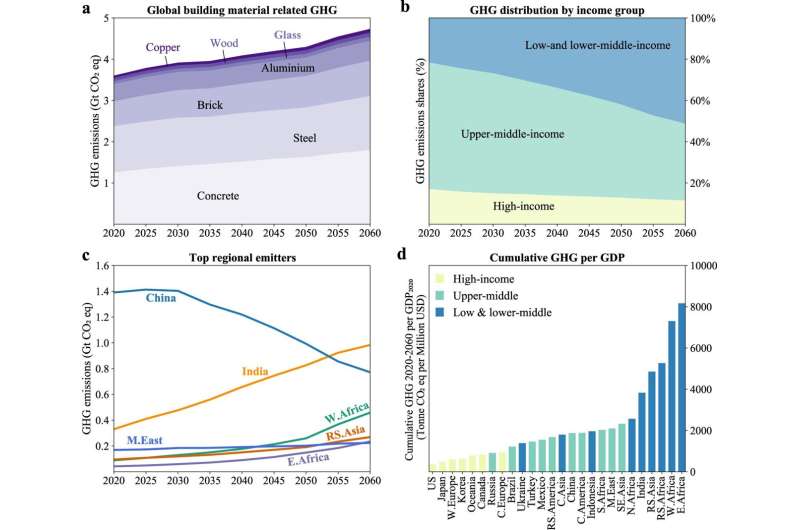Fig. 1: Greenhouse gas (GHG) emissions from building materials use for global regions in the Baseline scenario. a Development of global GHG emissions for seven materials during 2020–2060. b Percentage evolution of GHG emissions for three income groups during 2020–2060. c Development of emissions in the top 6 emitting regions (by 2060), occupying over 60% of the total, during 2020–2060. d Expected cumulative GHG emissions over 2020–2060 relative to present GDP (2020 value from the IMAGE integrated assessment model, at purchasing power parity) for 26 global regions. Credit: https://doi.org/10.1038/s41467-021-26212-z
A new study from Leiden researchers shows that the carbon emissions of building materials are set to grow if we do not act rapidly. Even with known interventions implemented in concert, these emissions are much larger than the remaining 1.5 degree budget for building materials at today's share, the researchers state in their Nature Communications paper.
In 2018, the production of materials for the building sector accounted for 11% of global energy and process-related emissions. Around half of global concrete, brick, and steel are poured into the building sector.
These emissions are expected to grow. "There will be a rapid need for shelter in the future as the last remaining areas of the world with growing populations need housing and increasing wealth drives a desire for bigger homes," says Ph.D. candidate Xiaoyang Zhong, lead author of the study. "The result is a prodigious amount of carbon emissions from materials such as concrete, steel, and glass. That's why we decided to study the growth of this sector and how we can mitigate its emissions."
Calculating environmental impacts
The research team investigated the growth in construction across the world by 2060. They then calculated the future greenhouse gas emissions in this scenario. The team estimated steel, concrete, brick, aluminum, copper, glass and wood requirements for 8 types of building, from detached houses to high-rise apartments, from warehouses to offices.
Worrying amount of emissions to 2060
The researchers also investigated 7 ways to limit emissions, such as living in smaller homes, using lighter materials, and building in timber rather than concrete. For example, they found that a third of emissions could be saved if people saw a 20% reduction in floor area per person from a baseline scenario where homes get bigger as wealth grows.
"Even when all the interventions are applied, we found a worrying amount of emissions to 2060," says Zhong. "They exceed double the current remaining budget for building material emissions based on today's share."
We need new solutions
"That's why it will help to have new technologies as well as circular economy approaches and behavioral changes. It's the only way to meet climate targets," Zhong continues.
"Decarbonisation of this sector is difficult for several reasons," says Paul Behrens, leader of the research team. "One of them is the fact that the high temperatures necessary for the production of metals, like steel, are harder to reach with electricity. Also, more than half of the emissions of concrete production arise from the chemical reactions needed in the process. It requires fundamental changes to the cement-manufacturing process to eliminate this."
Behrens thinks that there are some nascent technologies already available. "I think that technologies to inject carbon dioxide into concrete will certainly help, such as those CarbonCure is developing. Yes, you store carbon dioxide with this technique, but more importantly, it makes the concrete stronger so you need to pour less of it."
International collaboration on reusing materials
Another point of interest is that some areas around the world will still be urbanizing—such as South East Asia and Africa—while others are shrinking—such as Europe and East Asia. Behrens: "That's why we'll need more international collaboration on reusing materials across the globe so that we can make optimal use of the existing materials."
More information: Xiaoyang Zhong et al, Global greenhouse gas emissions from residential and commercial building materials and mitigation strategies to 2060, Nature Communications (2021). doi.org/10.1038/s41467-021-26212-z
Journal information: Nature Communications
Provided by Leiden University
























